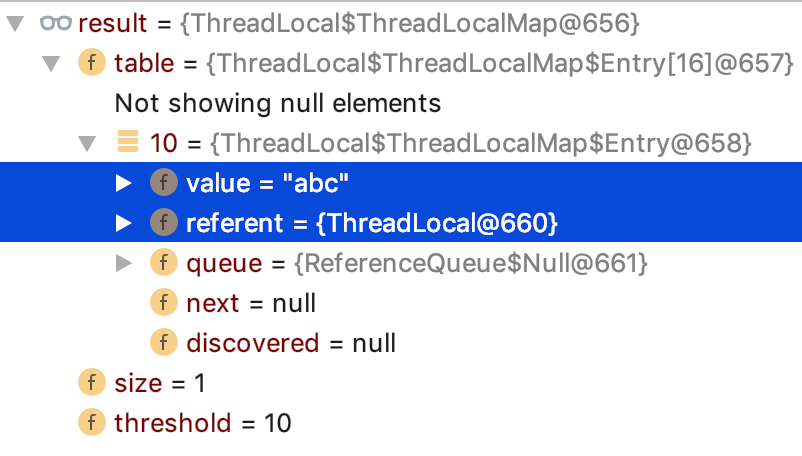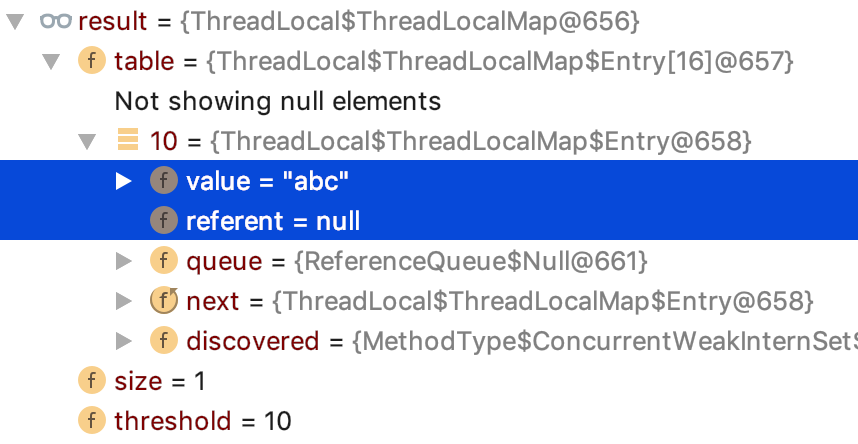理解 Java 中的 ThreadLocal
2019/08/03
引子
我们有了一个线程
Thread t = new Thread();
我们希望放置一些数据,使得在该线程的任何地方都可以访问和修改这些数据,这就是 ThreadLocal 对象。理所应当的,我们应该把这个些数据存放在当前 Thread 的对象上,这也就是为什么 Thread 类上有一个 threadLocals 字段,它的类型是 ThreadLocalMap,ThreadLocalMap 顾名思义是一个 Map,key 为 ThreadLocal 对象,value 是我们要存储的对象。
/* ThreadLocal values pertaining to this thread. This map is maintained
* by the ThreadLocal class. */
ThreadLocal.ThreadLocalMap threadLocals = null;
每一个 threadLocal 对象只能存放「一个东西」。如果你想存放苹果,再存放书,得分别为要存放的东西创建 ThreadLocal 对象:
ThreadLocal<Apple> appleThreadLocal = new ThreadLocal<>();
ThreadLocal<Book> bookThreadLocal = new ThreadLocal<>();
不过,到目前为止,仍然是什么特殊的事情都没有发生,因为 ThreadLocal 的构造函数是空的 :
/**
* Creates a thread local variable.
* @see #withInitial(java.util.function.Supplier)
*/
public ThreadLocal() {
}
多个线程可以使用同一个 ThreadLocal 对象:
public static ThreadLocal<Apple> appThreadLocal = new ThreadLocal<>();
// thread1 // thread2
... ...
Apple apple1 = new Apple(); Apple apple2 = new Apple();
appThreadLocal.set(apple1); appThreadLocal.set(apple2);
... ...
appThreadLocal.get(); // apple1 appThreadLocal.get(); // apple2
在整个 Thread.java 的源码中,只有 exit() 方法使用到了 threadLocals
private void exit() {
...
/* Speed the release of some of these resources */
threadLocals = null;
...
}
而 threadLocalMap 的初始化,是在第一个 ThreadLocal 对象调用 set 或 get 的时候发生的
/**
* Create the map associated with a ThreadLocal. Overridden in
* InheritableThreadLocal.
*
* @param t the current thread
* @param firstValue value for the initial entry of the map
*/
void createMap(Thread t, T firstValue) {
t.threadLocals = new ThreadLocalMap(this, firstValue);
}
我们来看一下set方法是如何执行的
/**
* Sets the current thread's copy of this thread-local variable
* to the specified value. Most subclasses will have no need to
* override this method, relying solely on the {@link #initialValue}
* method to set the values of thread-locals.
*
* @param value the value to be stored in the current thread's copy of
* this thread-local.
*/
public void set(T value) {
Thread t = Thread.currentThread();
ThreadLocalMap map = getMap(t);
if (map != null)
map.set(this, value);
else
createMap(t, value);
}
从 map.set(this, value); 可以看到,我们把要存储的值放到了 key 为当前 ThreadLocal 对象的 ThreadLocalMap 中去了。取值的时候也是从这个 map 中取,所以问题的关键就在于 ThreadLocalMap 的实现了。
ThreadLocalMap 的实现
跟 HashMap 类似,也是用数组来实现的
private Entry[] table;
然而这里的Entry 是 WeakReference 的子类
/**
* The entries in this hash map extend WeakReference, using
* its main ref field as the key (which is always a
* ThreadLocal object). Note that null keys (i.e. entry.get()
* == null) mean that the key is no longer referenced, so the
* entry can be expunged from table. Such entries are referred to
* as "stale entries" in the code that follows.
*/
static class Entry extends WeakReference<ThreadLocal<?>> {
/** The value associated with this ThreadLocal. */
Object value;
Entry(ThreadLocal<?> k, Object v) {
super(k);
value = v;
}
}
由于弱引用的特性,当 ThreadLocal 对象不可达的时候,ThreadLocalMap 的 key 就会被 GC 回收掉。试想,如果这里不是弱引用,而是强引用,那么 ThreadLocal 对象将永远不会被回收,除非线程终止。因为 Thread 持有 threadLocals,threadLocals 的 Entry 因为不是弱引用,就会持有 threadLocal 对象的强引用,如果不显式调用 ThreadLocal 的 remove 去掉这里的强引用,线程生命周期内,threadLocal 就不会被回收。当线程结束后,Thread 的 exit() 方法会执行 threadLocals = null 使得线程内所有的 ThreadLocal 对象以及其上面带有的 value 不可达,导致被回收。不过 exit 方法的注释上说,这里只是为了加速 资源的释放,即便线程执行 exit 的时候不释放,线程本身最终也会不可达,所有线程相关的资源最终还是会被回收。
我再画一幅图解释一下:(人类的本质是复读机!)
Thread t // 某一个线程
↓
ThreadLocal.ThreadLocalMap t.threadLocals // 线程持有的 Map 对象
↓
Entry table[i] // Map 持有的某一个 Entry 对象
-
假设 Entry 持有 key 和 value 的强引用,那么如果 ThreadLocalMap 不自己清理,key 和 value 就会伴随整个 Thread 的生命周期。
-
假设 Entry 是 key 的弱引用,那么 key 不可达时(也就是 threadLocal 不可达时),key 会被 gc,value 仍然伴随 Thread 的生命周期。
那么 ThreadLocal 对象在什么时候才会不可达呢?最简单的情况是,离开了函数调用栈空间了,我们来看下面这个例子
public static void test() {
ThreadLocal<String> t = new ThreadLocal<>();
t.set("abc");
}
public static void main(String[] args) {
new Thread(() -> {
test();
// 1
System.gc();
// 2
}).start();
}
在线程执行完 test() 方法后,执行 System.gc() 之前,也就是上述代码注释 1 的位置,当前线程的 threadLocals 对象如下:

可以看见 ThreadLocalMap 的 Entry 的 referent 和 value 都还在,当执行 System.gc() 后,我们看一下有什么变化:

此时由于 threadLocal 对象已经不可达,所以会被 gc 回收。然而,value 对象还没回收呢!
怎样才能让 value 对象也可以回收呢?上面已经说过很多次了,value 对象被回收当且仅当:
- ThreadLocaMap 自己清理
- Thread 对象被回收
下面我们来讲解 ThreadLocalMap 什么情况下才会自己清理 key 为 null 的 Entry
在 ThreadLocalMap 类中 ,真正可以回收 value (以及 key) 的方法是 expungeStaleEntry(int staleSlot) 方法:
private int expungeStaleEntry(int staleSlot) {
Entry[] tab = table;
int len = tab.length;
// expunge entry at staleSlot
tab[staleSlot].value = null;
tab[staleSlot] = null;
size--;
// Rehash until we encounter null
...
}
这个方法的实现是比较复杂的,不仅直接删除指定 index 的元素,并且在 rehash 的过程中也会清理一些其它的元素。
我们通过 IDE 分析调用链可以知道,只有在 ThreadLocal 的 get 、set、remove 方法被调用时,才有可能会进行清理。
注意事项
我们使用 ThreadLocal 最常见的场景是把 ThreadLocal 作为一个类的静态字段(即便不是静态字段,在 IOC 环境下,也可能是个全局的单例对象)多个线程共用同一个 ThreadLocal 对象。(也就是使用同一个 ThreadLocal 对象作为 key 放到各自线程 ThreadLocalMap 里)。
在这种场景下,ThreadLocal 对象的生命周期与承载它的对象的生命周期相同,在大多数 Web 场景下,这个 ThreadLocal 对象几乎在整个应用的生命周期中都是可达的。所以每个线程各自的 ThreadLocalMap 的 key 并不会因为使用了弱引用而被 GC 回收掉。我们只能够在每个线程中手动调用 ThreadLocal 的 remove 方法对 key 和 value 进行置 null,使得 GC 可以清理掉线程持有的 value(GC 清理不了 key,因为 key 总是可达)。如果不手动调用 remove,那么只有在线程被清理的时候,value 才会被清理(这里说了很多遍了,看不懂请重读上文)。
同时,在 web 场景下,大多数 http server 会使用到线程池,如果在上一次请求中没有主动调用 remove 进行清理,线程池为下一次请求分配的可能是同一个线程,那么调用 ThreadLocal 的 get 方法拿到的就是上一次线程存储的值,这可能会导致错误的业务逻辑。
因此,我们在使用 ThreadLocal 时,应该总是在当前线程结束前手动调用 remove 方法来清理这个线程的 ThreadLocalMap,否则,是有可能内存泄漏的(线程池中的每个线程的 threadLocals 都持有一个相同的 key 的 Entry,以及一个无用的 value)。